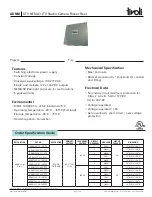
Print Date 12/05/15 Page 24 of 32 S7600-00MA-08
2.4.3 Reverted Status Monitor Information
The status of the Transmitter is reverted in response to a ? command (see section 2.4.2). After the
third byte is echoed back to the remote control unit, a further fifteen bytes are sent immediately from
the E2023, with no delays between individual bytes (each 1 start, 8 data, 1stop, no parity).
NOTE that
the E2023 must be left set on ‘MAIN’ mode for all the amplifier module status to be kept
updated (section 3.3).
The first fourteen of the fifteen bytes contains the specific status information requested. The last byte
is an exclusive OR checksum of those fourteen bytes. This checksum can be used by the remote
control unit to check that the information has not become corrupted.
The meanings of the various bytes in the information string are defined in the table below.
Reverted Status Information
(meanings of bytes reverted in response to
?
command)
Title
Meaning
Hex
ASCII
Norm
Status normal
4E
N
N_Norm
Status not normal
4F
O
Stat_Low
Status low
4C
L
Stat_High
Status high
48
H
Fail
Status fail
46
F
Fuse
Status fuse?
45
E
Auto
Tx/Drive on auto
54
T
Man
Tx/Drive on manual
59
Y
Drive_A
Drive preferred or on A
41
A
Drive_B
Drive preferred or on B
42
B
Drive_Pas
Drive passive
50
P
Drive_Act
Drive active/unmuted
55
U
Tx_Muted
Tx Muted
4D
M
Tx_Start
Tx Unmuted
53
S
N_Known
Not known
58
X
N_Applic
Not applicable
5A
Z
Direct Display
Numerical values
30-39
0-9
Direct Display
Sign
2B 2D
+ -
Direct Display
Decimal point
2E
.
Direct Display
Blank
00
NUL
Direct Display
Less than
3C
<
Most meanings are general. A string of fourteen information bytes would normally contain several ‘N’s,
each one indicating that a particular status (forward power, reverse power etc.) is ‘Normal’. Some are
specific, ‘A’ and ‘B’ for example, only refer to Drives A and B.
Direct display bytes give an immediate numerical display of power, current and temperature etc., even
when using a basic terminal program.
If the E2023 contains no known good information about a particular status, the ‘X’ byte is reverted.
This occurs if the E2023 is unable to interrogate individual modules within the Transmitter and thus
cannot determine their status. However, it should be noted that certain Transmitters do not have every
amplifier or power supply module fitted - status of such modules is thus returned either as ‘X’s
(amplifiers) or as ‘F’ (power supplies). The ‘Revert Output Status Request’ (ASCII 0) returns the
Transmitter type and can be used by the Remote Control Unit to determine whether a particular
module should, in fact, be missing and its status not known.
Note that the information returned may have a latentcy of one to two seconds, since the E2023 can
take that amount of time to collect the status of all the individual amplifier modules.
The following four tables detail the contents of the various strings of reverted status information. The
final column in each defines which ASCII values a particular byte can have. The table above defines
the meanings of these values. The first byte in each table is the echo of the third byte sent from the
remote control unit.









































